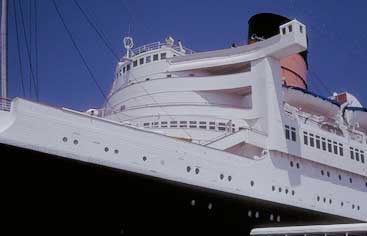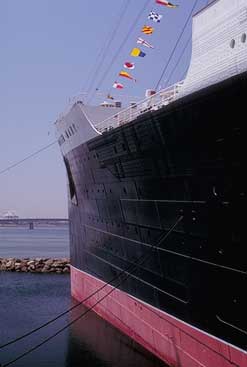Some External Views of the Queen Mary, 1996
When I arrived at the Queen Mary at about 8:30a.m., it was still foggy out
and the grey sky didn't do much for a photograph. I later learned that it
is like that every morning in Los Angeles. They call it the "marine air."
Fortunately, at about noon it looked like it does in these pictures.

The Queen Mary from the Dockside
The ship rides quite a bit higher in the water now than she did in her
days of service, as seen in the photograph above taken in June, 1996. Even
after removing the over 100 layers of paint that had been applied to
herhull and superstructure the Queen Mary rode an inch higher in the
water. After the removal of all her boilers and her two outer 62,500hp
steam turbine engines, she weighed 20,000 tons less and became extremely
top heavy. They poured oxygen-free drilling mud in to her double bottom
to stabilize her, and to maintain an even keel as she is docked here they
have to keep the correct amount of water in her oil tanks. I heard
recently she maintains a permanent 3 degree list to starboard that most
visitors do not notice. The vertical line you see coming down through the
3rd funnel is the bungee cord coming from the bungee tower next to the
bowon the dock.

The Sweep of the Bridge
Naval architecture advanced and progressed through the nineteenth in to
the twentieth century from wooden-hulled clipper ships to behemoth
steel-hulled liners like the Queen Mary. As the ships became bigger,
attempts were made to preserve some of the grace from their
predecessors,the clipper ships. The Cunard liner Mauretania is often said
to the Mary's direct predecessor in inspiration and style. When she and
the Lusitainia were sailing the Atlantic as a pair, they were known as
the Lucy and the Mary. Though the Queen Mary is of such immense
proportions compared to her older and smaller sisters, she actually
exceeds them ingrace and beauty as seen here in the beautiful lines of her
bridge and forward super structure.

The Curve of the Bow
Here is a view of the Queen Mary's huge and powerful bow. This is the
same bow that cut completely in half the British Cruiser Curacoa' in WWII,
killing over 300 men. We can also see here the well deck, that part of
the ship that many thought was a mistake by the designers and gave her
adated look even the day she first sailed. The Queen Elizabeth designers
omitted this feature giving her a more modern longer looking bow. But the
well deck on the Mary is part of her unique style and is a facet of her
elegant, traditional appearance while in her day possessing the most
modern and powerful engines ever put into a ship. So powerful that it
took 16 years for a faster liner, the SS United States, to beat
her.



